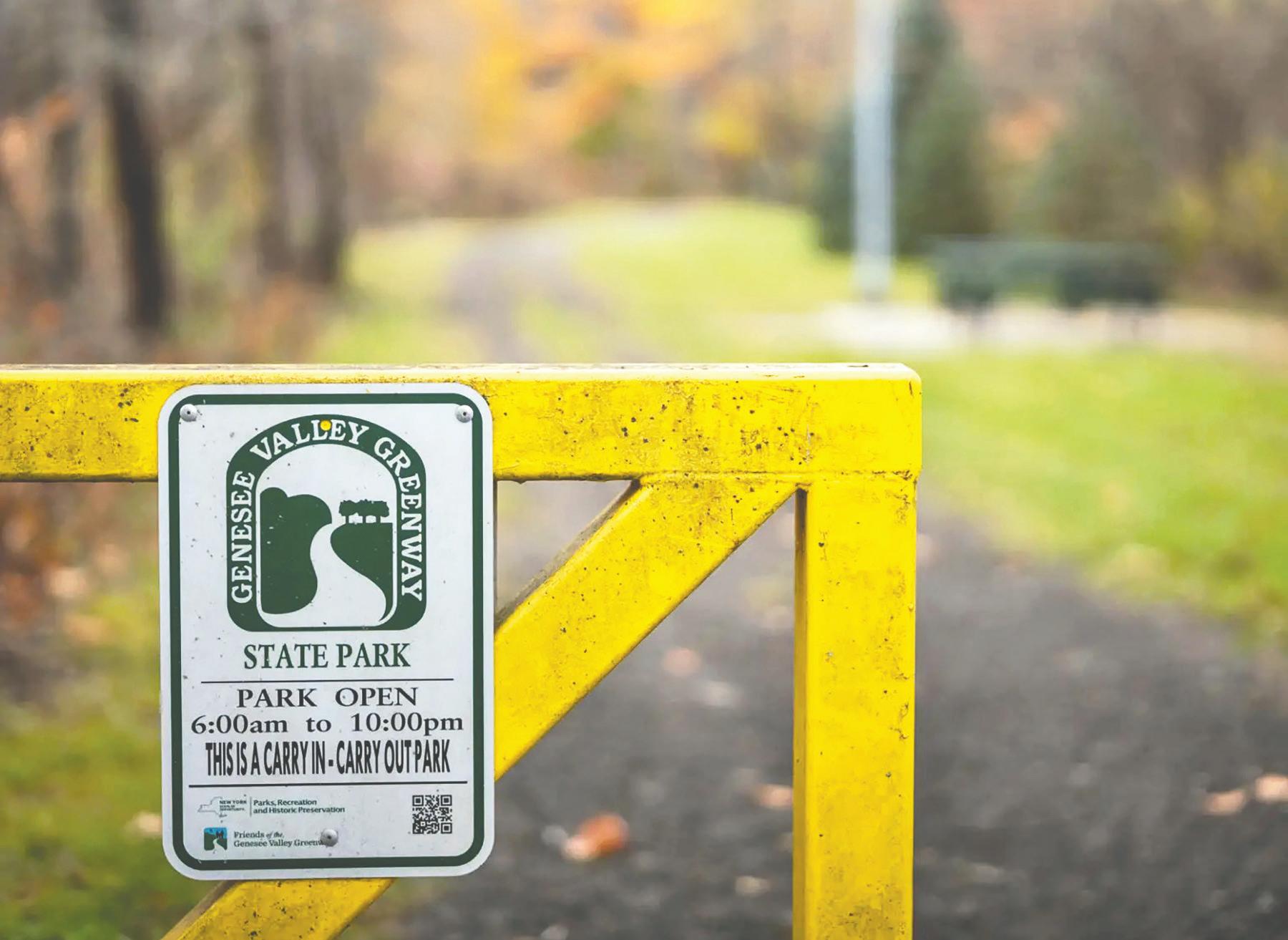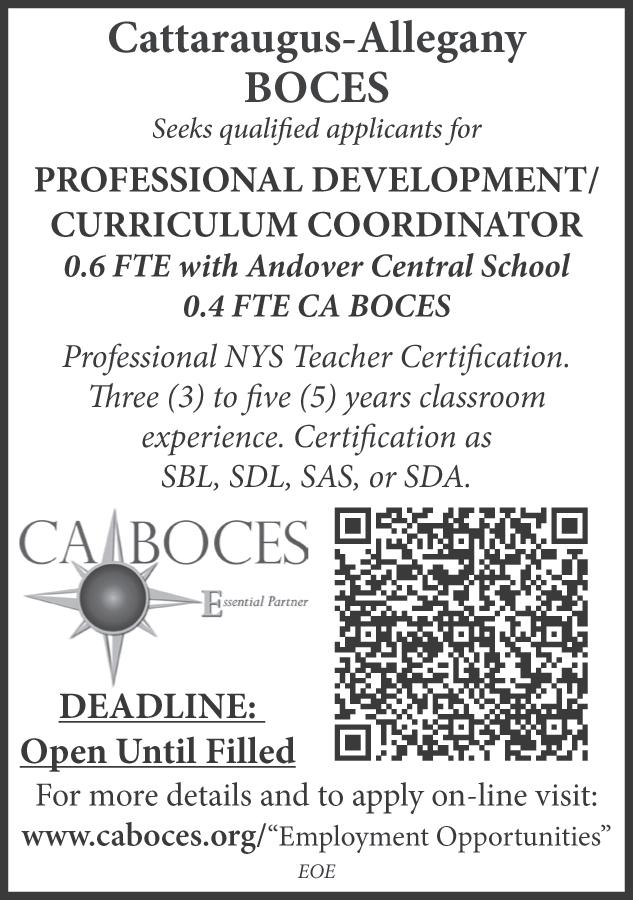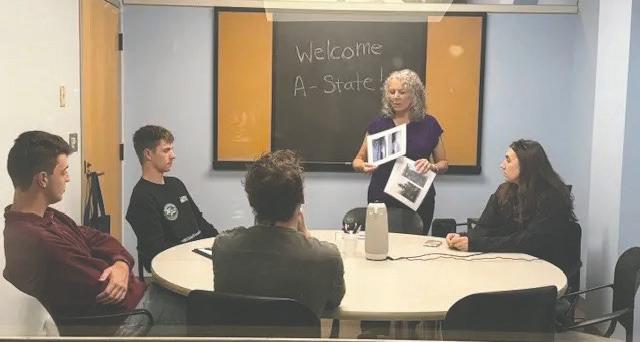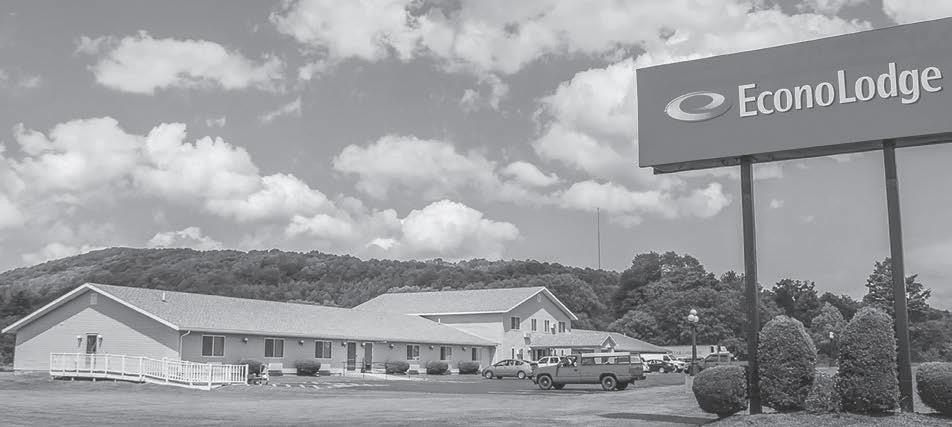
More than 200 gathered on bridge for the No Kings rally in Wellsville PAGE 2



More than 200 gathered on bridge for the No Kings rally in Wellsville PAGE 2

—
ROCHESTER
Alfred State alumni and friends gathered at the Genesee Valley Club to learn more about the college’s largest comprehensive campaign in school history and to salute the impact that Bill and Rhonda Goodrich’s gift of $1 million will make on the institution.
The comprehensive campaign, Unleashing Potential, has raised $33.7 million of the $40 million goal thanks to support from individuals like the Goodrichs. Bill graduated from
Alfred State with a construction engineering technology degree and joined LeChase Construction Services in 1985. He has risen through the ranks to become president, CEO, and to his current title of chairman and CEO.
“The Goodrich’s gift stands as a testament to a strong work ethic and a lifelong respect for learning,” commented Vice President for Institutional Advancement Danielle White. “It also reflects the deep alignment of values between
Alfred State alumni and LeChase — values that have elevated the firm’s reputation as a leader across the eastern United States. More importantly, the gift represents an investment in the future, ensuring that future generations of students have the opportunity to buildtheir own life journey.”
“We are so honored and proud to support Alfred State and unleash potential,” Bill Goodrich proclaimed as he stood












BY BOB CLARK
BELMONT — Allegany County officials want your help to plan for the future of the county’s trail network.
A draft of the Allegany County-wide Trail Master Plan has been released, county planning officials reported, and the public is welcome to review and comment on the plan by Nov. 7.
“The Allegany County-wide Trail Master Plan presents a comprehensive vision to guide the future planning and implementation of a county-wide network of public trails across Allegany County’s rural and mountainous








landscape,” said county Director of Planning Kier Dirlam. “The plan builds on previous local and regional planning efforts, community feedback, and stakeholder input to identify opportunities to expand recreational access, improve regional connectivity, and support active transportation through a more integrated and accessible trail system.”
The county is home to a number of trail systems, including the Genesee Valley Greenway, the WAG Trail, the concurrent North Country National Scenic Trail and Finger Lakes Trail, and various snowmobile trails.

“While the county has a strong tradition of outdoor recreation, including hiking, biking, hunting, and snowmobiling, trail development has historically been localized and fragmented,” the plan states. “This Master Plan represents the county’s first coordinated, county-wide effort to identify trail opportunities, prioritize investments, and align local, regional, and state partners toward a shared vision.”
The plan’s core goals include efforts to promote economic development through





























WELLSVILLE —
Some drivers honked in support, flashed peace signs and gave thumbs up when they drove under the Arterial pedestrian bridge Saturday morning in Wellsville, where more than 200 people joined in the No Kings protests held across the country.
The Wellsville event — held in. opposition to the Trump admin istration — was small by comparison to many across the country, but organizers said it was great in number for a predominantly Republican Allegany County. The county is the home
with his wife, Rhonda at the event. “Alfred State built a strong foundation and prepared us for where we are today. The programs are top notch in both the skilled trades and the management side. LeChase Construction has consistently
of two communities — Friendship and Angelica — that claim they, and not Ripon, Wis., are the birthplace of the Republican Party.
Activists on the bridge carried large signs so their messages could be read by drivers and passengers. Highlighted by the United States flag on both sides of the bridge, some of the signs decried No Kings, while others demanded “Release the Epstein files,” called for “Tax the Rich,” “End GOP Cruelty” and “Resist the Fist.” Those on the bridge responded to the honks
recruited and hired Alfred State graduates, and they are ready to hit the ground running when they start.”
During his remarks, Bill reflected not only on the impact that Alfred State had on his own life but on his compa-
of support with cheers and ringing cowbells.
The weekend was one of the busiest of the season for Wellsville, with the SPCA auction taking place a few blocks away, Artisan Tour signs within sight and RidgeWalk sandwich boards at every crosswalk. An estimated 20 to 25 vehicles passed underneath the bridge per minute.
There appeared to be no conflicts coming from the occupation of the bridge, which was constructed by and is owned by the New York State Department of Transportation and
ny. He highlighted that LeChase has ninety employees, past and present, who have graduated from the college. Graduates span seven decades and represent majors on both the Wellsville and Alfred campuses.
under the jurisdiction of the state police. It is located behind the police station on Wellsville’s Main Street, with many of the participants parking in the adjacent Tullar Field parking lot.
Neither state police nor local police officers appeared to be watching the event, which was widely publicized on Facebook.
Karen Ash, one of the organizers, noted that two to four “MAGA-hat-wearing” people showed up on the far north side of the bridge but, she said, “There was no interaction. This was a peaceful event,
management and skilled trades programs. I could not be more grateful for this incredible gift, their belief in the college, and unwavering support in our future.”

and we didn’t want any aggression.”
She offered that the organizers from Rise Up Wellsville and the Alfred Freedom Writers kept a close watch on the event and had appointed liaisons to the police, anti-protestors and the press in case anything happened.
The ranks of the group were predominantly middle-aged, white-haired and bearded, members of the greater Allegany County community and from
all walks of life, about 50/50, male and female, several with younger children in hand and with familiar faces from previous protests — including the the nuclear waste dump protests of the 1980s, the Iraq War protests and the eminent domain protests of a few years ago. As the sun drew higher in the sky, and the morning mist subsided around noon, the activists slowly began to file off the bridge.

ment, hands-on opportunities to the skilled trades, and endowed scholarships to promote and recruit students to the Alfred campus.”
• Ignite career readiness
• Power the Pioneer Fund













Previously, Bill has been honored with Alfred State’s President’s Medallion (2010) and was awarded an Honorary Doctorate by the State University of New York (2014).
Alfred State President Dr. Steven Mauro added, “The Goodrich’s gift of $1 million will support the construction
Bill concluded, “We believe in Alfred State. The gift is for the construction industry, split between programs on the Wellsville and Alfred campuses. It will provide simulators, equip
Mauro continued, “Alfred State is a launching pad for the next generation of leaders, innovators, and citizens. With continued support and partnerships, we will not just sustain our success — we will multiply it.”




































































Prior to the announcement of the major gift, Dr. Mauro highlighted the four pillars of the comprehensive campaign aimed at continuing Alfred State’s ability to provide a top-ranked, affordable education:







Amplify affordability
Energize our caring community
The evening, which included hands-on interactive displays showing the work done in the classrooms and labs around campus, concluded with the unveiling of the current progress of the campaign. Currently, the campaign has reached 85% of the goal.



























































































































































































































We’re coming off National Fire Safety and Prevention Week when numerous area fire departments throughout the Southern Tier and Finger Lakes regions held open houses to promote fire safety.
On Saturday in Elmira, a “Unity in the Community” event sponsored by Elmira Mayor Dan Mandell and Dr. Stephen Coleman focused on honoring and thanking firefighters and first responders. These events serve
as timely reminders of just how fundamental our firefighters and first responders are to the safety, security and strength of our communities — and they also serve to highlight the many challenges facing emergency services professionals and volunteers across this state.
For example, the theme of this year’s fire safety week was “Charged Into Safety” focusing on lithium-ion battery safety, which has risen to the top of the list of emergency services concerns and challenges as the use of these batteries has become an ever-increasing part of our everyday lives powering cell phones, laptops and other household devices, and, increasingly, electric cars, e-bikes and other vehicles.
This becomes especially alarming as New York continues rapidly imposing all-electric
mandates on all New Yorkers. It’s a serious concern for firefighters and first responders, one that I’m hearing more and more across my district.
In a recently adopted resolution, the Allegany County Legislature stated, “While lithium batteries provide convenience and innovation, they also pose potential fire hazards if not charged, stored or disposed of properly.
The 2025 Fire Prevention theme, ‘Charge Into Safety: Lithium Batteries in the Home,’ highlights the importance of educating the public on safe practices to reduce the risk of battery-related fires.”
these battery fires burn more rapidly and far hotter than what most firefighters have experienced, and require many more resources, including massive amounts of water, to put out.
According to a recent Spectrum News report, a national study in 2023 revealed that 40% of first responders and firefighters “had no training whatsoever in how to deal with electric vehicle fires and incidents.”
to evolve to reflect the transition from diesel to electric buses. The first question emergency dispatchers should ask when fielding a vehicle accident call is whether any of the vehicles involved in the accident are electric vehicles. Unless first responders have had training with electric vehicles, they should not touch the vehicle and should wait until trained personnel are on scene.”











Assemblyman Phil Palmesano and I recently met with the members of the Yates County Legislature to discuss key concerns, a number of which centered on New York state’s all-electric mandates and the challenges, dangers and uncertainty surrounding them — including the siting of battery storage facilities, the siting of solar projects on prime agricultural land, incentives for EMT training, the ability of the grid to handle what’s coming and the overall uncertainty facing county governments, school districts, fire departments and many others.
Battery fires have emerged as a particular concern and challenge requiring special response equipment and proper training in light of the reality that
That’s not a comforting statistic, particularly here in New York state where the Spectrum report goes on to note, “According to state records, there are more than 75,000 EVs registered in Upstate New York. The state projects three million EVs on the road by 2030. By the end of this year, a state mandate requires all passenger cars, SUVs and pickup truck sales to be 35% electric. By 2030, that number climbs to 68%.”
An article posted on the Firemen’s’ Association of the State New York website (fasny. com) highlights the concern, furthermore, of what’s facing firefighters and first responders surrounding New York’s all-electric school bus mandate.
“New York’s firefighters know how to respond to a fire or perform a rescue on the 47,000 diesel buses currently in service in New York. However, first responders’ training, procedures and equipment will need
It is a critically important safety issue yet Gov. Kathy Hochul recently vetoed legislation (S5848/A247), which I strongly supported and which was overwhelmingly approved in the Legislature with bipartisan support, that would have directed the state fire administrator to move forward on establishing a specialized electric vehicle emergency response training program for all first responders.
“While I find the goal of expanding EV training laudable, this bill would require the expenditure of funds that are not accounted for in the State’s financial plan,” the governor explained in her veto memo. “Any EV emergency response training would be more appropriately considered in the context of budget negotiations.”
On the governor’s veto, I’ll just say that New York state spending has skyrocketed to unprecedented levels, including a $15 billion increase in this year’s budget over last year,
during Hochul’s tenure, and I hope the governor will prioritize this critical action in her budget plan next year. In addition to all the above, local volunteer fire departments across the region and statewide, as well as local leaders in every county I represent, continue to highlight one of New York’s most daunting challenges: the recruitment and retention of local volunteer firefighters and EMTs. It, too, remains critically important for New York state’s future, especially throughout our rural, Upstate localities where the local volunteer fire department has long been a foundation and mainstay of so many communities. Its demise can’t be risked. As many of us have said repeatedly for many, many years now, keeping our corps of emergency services volunteers strong must be a statewide priority. Volunteer fire departments have long been the foundation of public safety and security, and the center of community service and strength, and civic pride.
Yes, our firefighters and first responders deserve every measure of gratitude and respect we can deliver. As legislators, however, we must remember that they need us to take important actions too, and we have to answer that call.
(State Sen. Tom O’Mara, who R-Big Flats, represents the 58th Senator District, which includes roughly the eastern half of Allegany County.)







WELLSVILLE — Appointments and public works resolutions dominated the agenda for the first village board meeting of October.
transfer station and the Genesee River in 2001, but the parcel never showed up on any map. The resolution also dealt with changing the status of the new hospital parking lot.






A short public hearing took place before the official meeting, with few people in attendance and no
objections to amending the village’s zoning map. The move included a change in status for a parcel of land not included on the previous map and a status change for the rebuilt Jones Memorial Hospital parking lot.
Mayor Ed Fahs explained that the village annexed a small portion of land between the
He further explained that the zoning board is working on a new map, and it needs to have an updated map to work from. The amended
map will show the parcels listed as R-2 rather than B-1 to reflect their current uses. In the regular board meeting, trustees passed a resolution to amend the map, which was prepared by Kier Dirlam of the county planning board.









































trail-oriented revitalization, foster interjurisdictional collaboration and planning, enhance regional connectivity of trail systems, expand equitable recreational access for all residents, ensure environmental and economic sustainability, and promote education and awareness of trail infrastructure and amenities. Working with the public, the effort analyzed strengths, weaknesses, opportunities and threats to the trail

system. In addition, The plan identified $93.4 million in projects across the county which would improve the trail system, with about $20.22 million in priority projects. The majority of the priority projects involve upgrades to the Genesee Valley Greenway to bring it up to state trail development standards, as well as signage to help users find trails across the county.
The document also identifies a number of federal and state grant
opportunities that could help pay for the work without placing additional burdens on county and local taxpayers. Plans such as the one developed are often required for grant applications and are helpful in landing grants over communities that have not engaged in exten-



sive planning efforts. The plan can be found at https:// www.alleganyco.gov/ wp-content/uploads/ TrailsPlanOct2025Draft. pdf. Comments may be submitted by email to Stacy.Beardsley@alleganyco.gov. For more information, call (585) 268-7472.







The kitchen may be the heart of a home, but health experts notes it’s also the dirtiest room in the house.
According to the National Sanitation
Foundation, areas where food is stored and prepared have more fecal contamination and bacteria than other places in a home, like the bathroom. The NSF
found more than 75 percent of dish sponges and rags tested positive for salmonella, E. coli and fecal matter. This is a much higher percentage than bathroom

faucet handles, 9 percent of which were found to contain these harmful microorganisms. Kitchens also are vulnerable to additional pathogens. Since food is found in kitchens, there may be higher rates of insect and animal pests, which come with their own health dangers. Pest droppings can be a serious health hazard that contaminate food sources and spread airborne pathogens that can trigger asthma and allergic reactions. Pest waste also can lead to gastrointestinal upset. Kitchens require frequent cleaning. In fact, the following daily cleaning tasks can help

























































































































































































































keep people safe and healthy.
• Wash dishes. Hand wash all dishes or load them into the





dishwasher promptly after use.
• Clean away clutter. Remove unnecessary ingredients, tools
allegany county Community Source home improvement
and other items that do not need to be on countertops, as such items may be vulnerable to contamination.
• Address surfaces. Use an all-purpose cleaner to clean countertops and the stovetop. Clean up spills as they happen. Look for cleaners that offer microbial protection, but warm, soapy water also works.
• Clean frequent-use items. Cutting




boards, the coffee maker, the kitchen sink, and areas of the refrigerator that come in contact with uncooked and unwashed food require frequent, thorough cleaning.
• Soak sponges. Sponges can collect germs. Heating damp sponges in the microwave for a minute can kill bacteria, offers Healthline. Sponges also an be soaked in a quart of


warm water with half a teaspoon of concentrated bleach. Others have said to run sponges through the dishwasher cycle to sanitize.
• Wipe down handles. Take time each day to wipe refrigerator handles, stove knobs, microwave handles, faucets, and light switches in the kitchen.
• Replace towels. Frequently switch out kitchen towels,
and especially if they have come in contact with raw food. Use a separate towel for drying hands than you do for drying dishes.
• Clean the floor. Vacuum the kitchen floor each day, particularly after dinner. Routine mopping also ensures floors remain clean.
Keeping on top of kitchen cleaning each day can keep these popular areas safe for all.













ALFRED — A group of Alfred State College marketing and business students recently visited Alfred University, where they toured a College of Business facility used for conducting focus groups. The 13 students from the Consumer Behavior class taught by Susan Gorman, associate professor of marketing at Alfred State, participated in mock focus groups and discussed how consumer data collection is used to develop marketing strategies.
In additional mayor’s business, the board approved the plan to digitize records (Code 360). This will allow anyone to search the village records from recent changes in laws to zoning information, which will be accessible through the village website. The initial cost, $23,000 and a yearly maintenance fee of $1,300, received board approval.
Former Mayor Randy Shayler, who
Gorman said she brought her class to tour the facility in Alfred University’s Olin Building—which includes the focus group room, a studio for producing podcasts, and a study area—at the invitation of Shelly Freyn, associate professor of marketing at Alfred University.
“We are developing surveys, looking at consumers from different points of view, seeing how consumers relate to businesses and how businesses gather data on consumers,” Gorman
resigned in September, was appointed to the village’s economic development board at the request of Fahs. Two resolutions were accepted concerning the public works department. After discussion with the department, it was deemed necessary to purchase a new computer server to be utilized in all functions of the department at a cost not to exceed $10,000, which will be appropriated from the































said. “Shelly told me about the focus group room and invited me to bring my class over.”
Freyn said she organized two mock focus groups that the Alfred State students took part in. Students participated both as focus group members and as observers from an adjacent room. “One focus group was for Nike testing a new flip-flop; the other was for Nestle and a new chocolate cookie,”
general fund reserves. The resolution was offered by Trustee Mike Roeske and approved by the board.
New Trustee Tim Culligan also brought forth a resolution to purchase a shed for the water department. The cost of the new structure shall not exceed $12,000, which shall be appropriated from water fund reserves. The board passed the resolution with no objections.
In late summer, the





Municipal Association for Code Enforcement (MACE) took over the duties of code enforcement for the village. It is also employed by several other municipalities in the area.
At the recent meeting, the board noted that there has been a slight increase in the cost of investigation from $9 to $10 per parcel.
“They are a very, very frugal group,” Fahs said, adding that he is very pleased with










































































































































their work. In fact, the village is so pleased that it gave MACE a great deal on a 2021 Dodge Charger with 55,000 miles on it, formerly used by the police department, for a purchase price of $9,000. It was going to be traded in, noted the mayor. The board approved selling the vehicle to MACE. “They’re getting a great deal,” Roeske commented, With board approval, part-time cleaner Sha-

































































































ron Strobe will also take on the duties of writing parking tickets and notifying violators. Also, before adjourning in time to watch the Buffalo Bills game — a concern expressed by several trustees — the board approved the appointment of Jane Biddle to replace Brooke Deming as part-time utility billing clerk. The next village board meeting is set for 6 p.m. Oct. 27 in the village hall.




Halloween is a highlight of fall, as children and even adults anxiously await October 31. Similar to the holiday season, people often decorate their homes for Halloween, and even do so well in advance of late October to maximize the amount of time they get to enjoy the trinkets and other items. Many people enjoy getting hands-on for Halloween. It’s possible to craft decorations, personalized treats and festive costumes. Consider these ideas for Halloween craft projects.
Carving pumpkins is a popular Halloween tradition. But there are many people who feel the job is too messy. Instead, a fun way to add personality to pumpkins comes by way of some hot glue and paint. Use a hot glue gun to create a pattern on the outside of the pumpkin. It can be designs, a jack-o’-lantern face or just about anything. Once dry and hardened, use craft paint to go over the entire pumpkin. The raised design will be evident and add dimension.
Adorn the front door with something creative. It can be utterly frightening or something more festive. Start with a premade spring greenery wreath or a wreath frame that you cover with your own greenery. Purchase a round, unfinished wooden sign panel, and paint with black chalkboard paint. Add your own message with chalk or chalk paint. “Keep Away” or “Enter at Your Own
Risk” are great Halloween phrases to consider. Attach the sign in the middle of the wreath. You also can add some embellishments to the wreath, including black moss and floral stems and leaves. A glittery black and green ribbon or bow is the finishing touch before hanging.
Boo Treasure Box
Purchase a wooden treasure chest or box from the hobby store. Paint it all black or your favorite Halloween colors. Then add additional designs like spider webs, bats or pumpkins. Fill the box with treats or small toys. Kids can have fun picking out their treasures.
Halloween Gnomes Gnomes have been popular for years, and they keep turning up in different iterations. You can craft your own gnomes for Halloween with a few supplies. Start with a 9-inch-tall foam cone. Cut the bottom off the toe part of a solid colored ankle sock just past the heel, and pull it up so it covers the lower few inches of the cone. Add some hot glue to secure, draw a beard shape on the back of the faux fur and cut it out. Attach the beard to the lower part of the cone over the sock. Use a crew length patterned sock to create a hat for the gnome, and glue to the top part of the cone. Glue on a large wood bead for the nose. Decorate the gnome any way you’d like, such as adding felt patches to the sock hat.
Halloween can be even more fun with some creative crafts the entire family can enjoy.











































































































































































































WELLSVILLE —
Jones Memorial Hospital Rehabilitation Services is participating in the PT For Future Me campaign, a national effort by the American Physical Therapy Association under its ChoosePT initiative. It encourages Americans to see physical therapy not just as a
treatment for injury but as a lifelong strategy for moving better, aging stronger and living fully. A national survey commissioned by APTA reveals that while many Americans worry about declining heart health, physical changes like wrinkles or dying young, most (66%) say their greatest fear about
BELMONT — The Allegany County Office for the Aging is looking for volunteers to help people with their tax returns.
Prior experience is not necessary, but if you like working with numbers, are comfortable using computers, have experience in filing your own tax returns and have some free time during the months of January, February, March and April, this may be a chance to use your skills and make a difference. Participants will receive free tax law training to help prepare basic
tax forms. The training is in Belmont on Jan. 12, 14, 16, 20, 21 and 23.
The Tax Counseling for the Elderly Program (TCE) offers free income tax assistance for low to moderate income Allegany County residents. Volunteer tax counselors are trained and certified to help people who are 55 and over with federal and state returns.
The Office for Aging partners with the American Association of Retired Persons (AARP) and the Internal Revenue Service (IRS) to provide the TCE program. Anyone interested may call (585) 268-9390.
Freyn said. “The students came up with the ideas.”
“The students played the role of consumers and were able to see how data is collected and decisions are made,” Gorman related.
After the focus group exercises concluded, Freyn and Gorman engaged the students in a discussion of ideas for conducting market research and developing marketing strategies.
Gorman said the in-person setting of the focus groups gave her students a better understanding of how
consumer information is gathered and how it is analyzed. The focus groups in the facility in Olin can be observed through one-way glass and on a closed-circuit television monitor.
“You can view the facial features and body language, see their reactions,” Gorman said.
“It tells a more complete story of how the consumer feels. You can’t get that with a paper survey.”
Freyn and Gorman agreed the visit helped students gain a broader understanding of the comprehensive nature
aging is losing the ability to do the things they love.
PT For Future Me challenges the notion that physical therapy is only for recovery. Instead, it positions physical therapy as a core component of a proactive, comprehensive health and wellness plan — as routine and valuable as annual checkups or dental visits.
Cathy Zacher, director of rehabilitation services at Jones and a board-certified clinical specialist in pediatric physical therapy, emphasizes that everyone, from young athletes to older adults, can benefit from physical therapy.
“It’s important to note that individuals do not need a physician’s referral to see a physical therapist for evaluation and treatment in all 50 U.S. states and Washington, D.C.,” she said.
After a thorough evaluation, a physical therapist will develop a plan for each person’s unique needs and abilities and work with them to improve their movement to help them stay healthy, active, and reach their health and wellness goals.
“We often see people
of developing marketing strategies.
“This was a great opportunity to show students that marketing is not just advertising, or making a Tik-Tok video,” Gorman commented. “It’s so much more than that.”
“The students got a real taste of how focus groups work,” Freyn added. “It broadens students’ minds beyond just advertising. This shows students the front-end research that provides the data for marketing campaigns and ads.”
Freyn and Gorman

wait until something goes wrong before turning to physical therapy,” Zacher said. “The PT For Future Me campaign flips that mindset. Physical therapy isn’t just about recovery — it’s about prevention, strength, and longevity.
We want our community to see physical therapy as a lifelong resource for moving well, feeling strong, and doing the things they love at every stage of life.”
The PT For Future Me campaign equips
hope there are opportunities for students from Alfred University and Alfred State to collaborate on future market research projects utilizing the focus group room. She referred to Alfred Market Insights (AMI), a student-run organization operating under the umbrella of the Alfred University College of Business’s Institute for Experiential Entrepreneurship (IEE), which conducts market research for area businesses.
“We’ll need students, from Alfred and Alfred State, to participate in
people with the tools and information they need to make physical therapy part of a proactive health strategy.
Resources include a comprehensive patient education toolkit covering the role of physical therapy across the lifespan, and interactive materials to help people take charge of their health.
For more information visit choosept.com or call the Jones Memorial rehab department at (585) 596-4011.
and run (AMI) focus groups,” Freyn said, noting that last year, Alfred State students served as panelists on a focus group for local business Honey Pot Chocolates “We hope there are other future opportunities to collaborate with Alfred State.”
“There is a lot that Alfred University and Alfred State College can do together,” Gorman said, noting the number of small businesses in the region that could benefit from market research services provided by students.
Alzheimer’s disease is a progressive and debilitating condition that slowly robs a person of their memories and personality. Alzheimer’s disease is a form of dementia that produces various symptoms that occur in stages, ultimately arriving at a point when a person can no longer live independently due to cognitive decline.
The Fisher Center for Alzheimer’s Research Foundation says there are seven clinical stages of Alzheimer’s. Stages 1 through 3 are the pre-dementia stages,


while stages 4 through 7 are the dementia stages. Here is a close look at what these stages entail, according to the Global Deterioration Scale.
Stage 1
There is no cognitive decline, nor noticeable symptoms.
Stage 2
A person may experience very mild cognitive decline. This can include one feeling like he or she is having memory lapses, but no symptoms of dementia can be detected by others, including medical professionals.


Stage 3
During stage 3, mild cognitive decline begins to become noticeable. Friends, family or coworkers begin to notice difficulties, which may include problems coming up with the right words or names; trouble remembering names; greater difficulty performing tasks; and losing or misplacing a valuable object.
Stage 4
A careful medical interview should reveal symptoms of moderate cognitive decline. Forgetfulness of recent
events; difficulty performing complex tasks like planning a meal for guests or paying bills; forgetfulness about one’s own personal history; and becoming moody or withdrawn are possible.
Stage 5
Cognitive decline continues to progress to where it becomes moderately severe. Gaps in memory are noticeable and individuals likely will need help with everyday activities. Some may be unable to recall their addresses or telephone numbers, while













others may be confused about the day or where they are. Stage 5 is usually the stage when a person can no longer live without assistance.
marked by profound cognitive impairment. Loss of mobility and effective communication typically occurs at this stage.





Stage 6 Very severe memory loss, loss of communication skills and inability to recognize loved ones occurs during the severe cognitive decline stage. One will need total care.
Stage 7
This is the end-stage of the disease and is
It’s important to note that these stages are general guidelines of what can be expected as Alzheimer’s disease progresses. Symptoms may vary among different people, and not everyone with Alzheimer’s will progress through these stages at the same rate.